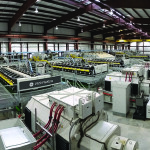With 38 tri-fuel engines and a combined capacity of 573 MW, IPP3—a plant constructed near Amman, Jordan—is now the world’s largest internal combustion engine–based power plant.
The facility was inaugurated on April 29 in a ceremony attended by Jordan’s King Abdullah II Ibn Al Hussein. The plant was constructed by an engineering, procurement, and construction consortium led by Wärtsilä, which has installed 58 GW of power plant capacity throughout the world and also offers power solutions for marine markets.
IPP3 utilizes the 50DF engine manufactured by Wärtsilä. The units will run on heavy fuel oil as their main fuel source until the supply infrastructure is in place for liquefied natural gas to be used later this year. The engines can also operate on light fuel oil as a backup.
Amman Asia Electric Power Co. (AAEPC) owns the plant, which entered service late last year. The operational flexibility of the plant has allowed Jordan’s combined cycle gas turbine and steam turbine plants to operate at a more stable, baseload output.
“By starting one engine at a time, the plant can follow the demand very precisely,” said Taemin Kim, administration manager of AAEPC.
According to data provided by the local grid operator, the effect on the Jordanian power grid has been positive. Since IPP3 and its 250-MW sister plant, IPP4, came online, the units have absorbed a significant portion of the daily and seasonal load fluctuation in the country.
“This empirical evidence shows how our Smart Power Generation power plants can optimise entire power systems by providing much-needed flexibility. Using [internal combustion engines] for peak load and gas turbines for baseload is the perfect combination in improving overall efficiency of the grid,” said Upma Koul, business development manager at Wärtsilä.
Wärtsilä has experienced strong growth in the Middle East. The company announced earlier this week that it would provide engines for two plants in Oman with a combined capacity of 104 MW. It has also received orders from Saudi Arabia and says it has about 7 GW of installed capacity in the region.
—Aaron Larson, associate editor (@AaronL_Power, @POWERmagazine)









